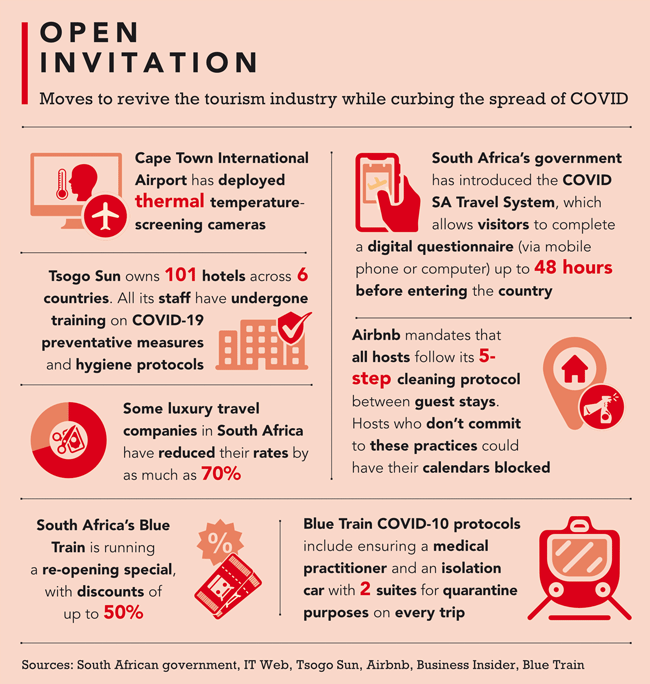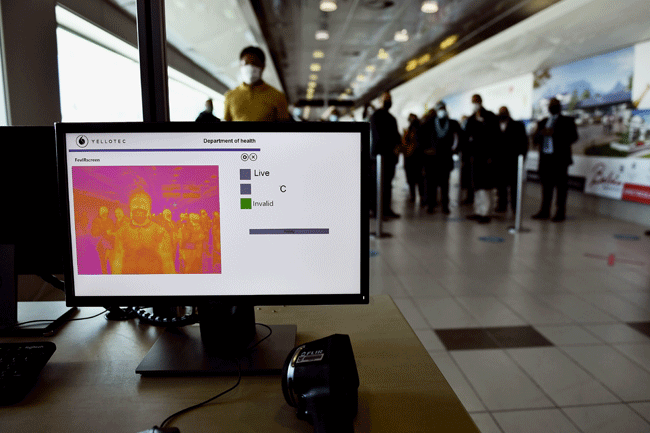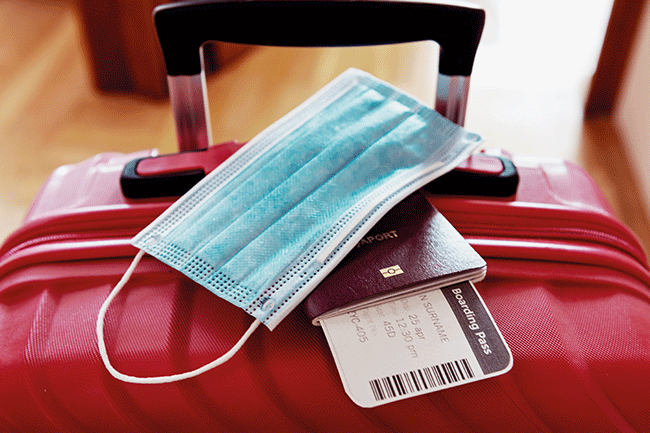The first COVID-era airport terminal – which happens to be in Africa, more specifically in the Ethiopian capital Addis Ababa – gives travellers a glimpse into the future of travelling. It’s a smart future in which the passenger experience is tech-driven, touchless and seamless, where personal mobile phones are ‘must-haves’ and proof-of-test or -vaccine becomes an essential travel document. ‘What makes our new terminal unique is that it’s the first terminal in the world to be completed after COVID-19. It was designed, not re-purposed, with biosafety and biosecurity in mind,’ said Ethiopian Airlines group CEO Tewolde GebreMariam after the flag carrier’s new terminal was officially opened at its hub, Addis Ababa’s Bole International Airport, in September 2020.
In line with global COVID-19 guidelines to reduce physical touchpoints at airports, the new terminal has 30 self check-in kiosks and 10 self bag-drop stations in the check-in hall. There are 60 staffed check-in counters and 16 immigration counters, which have provisions for automated border-control systems. Known as e-gates, these automated self-service barriers use biometric technology such as face, fingerprint or iris recognition to verify a traveller’s identity against their e-passport.
The benefits of end-to-end biometrics, self check-in, self bag-drop and self scanning of boarding passes include far quicker passenger processing, fewer immigration violations, improved anti-terrorism security and – important during the pandemic – a reduction in queues and physical contact between passengers and staff.
‘COVID-19 is fast-tracking existing travel technology. It’s been a catalyst to accelerate automation trends that were already under way in Africa,’ says aviation expert Linden Birns, owner of consultancy Plane Talking in Cape Town. ‘COVID has arrived at a time when a lot of self-service tech at airports is coming to the end of its useful life, certainly in South Africa. So the question is: with people relying on mobile devices, do we still need kiosks or just QR scanners in future?’
The biggest issue for resuscitating Africa’s travel sector is, however, the availability of COVID vaccines, says Birns. Until a vaccine is rolled out, testing and social distancing will remain crucial. To streamline the patchwork of individual government testing and quarantine requirements, industry bodies such as the International Air Travel Association (IATA), International Civil Aviation Organisation and Airports Council International (ACI) are pushing for common global standards. To this end, IATA wants to launch its ‘travel pass’ for travellers worldwide in early 2021.

‘The IATA Travel Pass is a digital health pass on your cellphone, containing information about your COVID test results or vaccination status, that allows you to connect with labs, immigration authorities and airlines,’ says Birns. ‘It’s a digitalised version of travel health documents for yellow fever, small pox or hepatitis inoculations, which passengers currently carry on various bits of paper.’
It incorporates a module for a contactless-travel app that enables passengers to create a ‘digital passport’, receive test and vaccination certificates, and share testing or vaccination certificates with airlines and authorities. According to IATA, the app ‘can also be used by travellers to manage travel documentation digitally and seamlessly throughout their journey, improving the travel experience’.
Birns says that 15 years ago, IATA managed to phase out paper airline tickets in favour of e-tickets. And just like that, COVID-test or vaccination certificates could soon be stored as a QR code on passengers’ phones rather than having paper print-outs, as is required in South Africa, Kenya and the rest of Africa.
The continent’s airports are at different stages of tech maturity, ranging from those with personnel-intense traditional passenger processes to those that have already deployed smart tech and automation at various processing nodes. ACI’s Guidance for African Airports Restart is a roadmap on how to update existing business continuity plans to get the aviation industry going and instil confidence in those wanting to travel. The document advises, for example, on the increased cleaning and disinfection requirements especially of floors and of surfaces with a lot of hand contact, including self-service kiosks, counters, baggage trolleys, lifts, handrails or scanners. In some US airports, the floor cleaning is done by robots – such as the one in Cincinnati, which National Geographic describes as a ‘1 000-pound, US$50 000 floor-scrubber that looks like the love child of a rolling suitcase and an outboard motor, and which uses 3D technology and lasers to map its routes’. At Pittsburgh International Airport, cleaning bots have been updated with an ultraviolet C component whose wavelength destroys the DNA of a virus.
Compared to harnessing UV light to kill traces of coronavirus, the ACI’s advice for African airports to install foot-operated hand-sanitising stations seems decidedly low-tech. But it’s proven effective in curbing infection, and when Nairobi’s Jomo Kenyatta International re-opened for international flights in August 2020, after four months of closure, it featured 300 automated sanitation points across the airport.
Meanwhile, health screening has become part of the touchless airport experience. Airports have introduced handheld infrared thermometers, thermal scanners and full-body infrared scanners to check travellers for fever as a potential indicator of COVID infection. In September 2020, Cape Town International started using thermal-imaging cameras at all terminal entrances, which screen passengers as they walk past. An alarm sounds if someone’s temperature is too high.
Rome’s Fiumicino Airport in Italy has taken this one step further, and is using advanced head-mounted thermal-scanning tech. The dystopian-looking helmet with dark visor, which has been termed ‘terrifying’ by journalists, can read the maximum temperatures in a crowd of people simultaneously. And as if that wasn’t enough, it can also be used for real-time facial recognition when paired with 5G, WiFi and bluetooth hardware.
Yet temperature checks have one weakness: they don’t detect people who are infected but don’t have a fever. A New York-based company has developed a device, SymptomSense, that works like a metal detector gate: as passengers walk through it, their temperature, blood-oxy-gen levels, heart and respiration rate are taken. The only touchpoint is their right thumb, which needs to be placed on the device’s pulse oximeter (for which a disposable glove is provided). Such visible tech innovations may help strengthen the confidence of people wanting to travel and lower their perceived risk.

‘COVID-19 is likely to result in a change in the psyche of tourists who will make different choices with regard to travel,’ says Diane Abrahams, director at the University of Johannesburg’s School of Tourism and Hospitality. ‘For recovery and growth of the sector, there is a need for further engagement with the disruptors of the sector as they will assist the more traditional side of the sector through this crisis. We need to encourage innovation and the use of smart technology by tourism entrepreneurs. The sector as we know it will settle on a new equilibrium influenced by the tourist’s new thinking and feeling around travel and tourism.’
To unleash new and disruptive ideas, the Solution Space at the University of Cape Town’s Graduate School of Business recently hosted a virtual Future of Tourism Bootcamp. More than 60 participants from South Africa and Botswana shared innovations such as Digital Badge (an online training-based platform on COVID-19 protocols) and Beyond Borders (an app and web-based solution that enables street views of different environments and experiences). The winning app, ArtDriveThrough, is a virtual art tour that combines mobile technology with an actual road trip, thereby lending itself to COVID-era art exhibitions, festivals and conferences, where large gatherings remain restricted.
Virtual tourist experiences – notably live-streamed wildlife cameras or safaris in Africa – have been around for some years but became even more popular during lockdown. Although they are streamed for free, they build up loyal international (and increasingly also local) audiences who tend to bond with certain animals, rangers or locations, which sometimes translates into tourist bookings later down the line.
In a similar vein, the One Day Western Cape campaign in South Africa presented virtual tours of the region to an armchair audience, reminding them that one day, they would be able to explore all this in person again. Viewers were encouraged to leave a tip via SnapScan, to financially support tour guides who had lost their income during the pandemic. The campaign also included a unique podcast sleep series, with rich soundscapes from the region to inspire listeners to dream of the Western Cape.
As technology has brought people virtually closer to Africa during the first phases of COVID-19 and its travel restrictions, it should now be used to make them feel safe enough to physically travel here.
The health and hygiene protocols are in place; the airports are ready. And while much has changed in the world, Africa may be the ideal pandemic-era destination with its vast open spaces, abundant wildlife and nature, and sunny climate.


